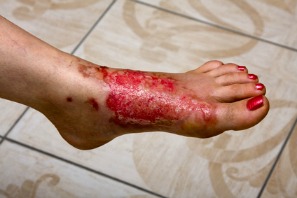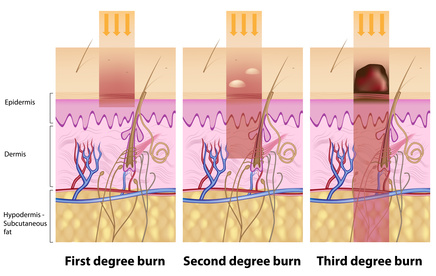Skin Burn Treatment
Visit this
PICTURES OF RASHES PAGE
A skin burn treatment varies depending on what caused the skin burn and the severity of the skin burn.
Skin burns are a leading cause of injury in the home environment. Children and elderly individuals are particularly vulnerable. Skin burns can be caused by:

- Heat – dry heat such as from a fire or other heat sources, moist heat such as steam, and friction
- Chemicals – corrosive compounds such as acids and alkaline compounds
- Electricity – contact with live electrical current
- Radiation – overexposure to the sun or contact with radioactive materials
The severity of the skin burn also determines the skin burn treatment that is required. Skin burns are classified into three main categories.
First Degree Skin Burn
A first degree burn is a superficial burn on the skin’s surface or epidermis. Generally, the skin is red, there may be some slight swelling, and the amount of pain varies from mild to severe. A minor first degree burn involves less than 20 percent of the body and the face, hands, feet, or genital areas are not affected. A moderate first degree burn means that 50 to 70 percent of the body has been affected. Finally, a critical first degree burn occurs when greater than 70 percent of the body has been burned.

Second Degree Skin Burn
In this case, the top layer and second layer of the skin (epidermis and dermis) are damaged. Symptoms are raw, moist skin that is white to cherry red in color, and blisters that leak clear fluid. Pain is usually extreme. A minor second degree burn is generally less than 15 percent of total body area. A moderate second degree burn involves 15 to 30 percent of the total skin area, and a critical second degree burn means greater than 30 percent of the skin has been affected (greater than 20 percent in children).
Third Degree Skin Burn
This is a deep burn with damage down to the nerves, muscles, and fatty tissue. White waxy skin may be evident and the skin may become dry and leathery in texture. The skin and underlying tissues will be charred. Often the victim has very little or no pain in the deeply burned area, although less burned areas will be very painful. A minor third degree burn is when 2 percent of the body is affected. A moderate third degree burn means 2 to 10 percent of the body has been affected – not including the face, hands, or feet. Finally, a critical third degree burn is characterized by greater than 10 percent (greater than 2 percent in a child) of skin area affected or burns to the face, hands, feet, or genitals.
A burn treatment and medical attention is always required when the burn is deep, covers a large area, is in the facial area and affecting breathing, involves a child or elderly person, and is due to electricity or chemicals.
Skin Burn Treatment for Heat Burns
For heat burns, immediately immerse the burned skin in cool clean water to relieve the pain. Alternatively, pour cool clean water over the burned area or apply a clean cool cloth. This will relieve pain and reduce swelling and blistering. The burned area may be covered with a sterile dressing and seek medical attention if the burn is severe or covers a large portion of the skin.
Do not apply lotions, oils, creams, or butter to the burn injury.
Skin Burn Treatment for Chemical Burns
Generally, the skin area that came in contact with the chemical should be flushed immediately with clean cold water for at least 15 to 20 minutes and the contaminated clothing should be removed. Medical attention should be obtained. Some chemicals required different treatment procedures. Consult with labeling of each specific chemical, if time permits, for alternative skin burn treatment.
Skin Burn Treatment for Electrical Burns
Third degree burns usually result when an electrical burn occurs. In addition, more serious health problems can also result. Seek medical attention immediately.
Burn Treatment for Radiation Burns
For minor sunburns, sponge the burned skin area with cool clean water. Alternatively, cover the affected skin with a clean cloth soaked in cool water. Apply a cream or ointment specially formulated for sunburns. Cover up sunburned areas to avoid increasing the damage to the skin by more sun exposure. In addition, do not pop any blisters, which may form.
For major sunburns, more serious health problems may develop and therefore, medical attention is required immediately.
For burns when the underlying tissue is exposed, infection is likely. Ensure that a proper skin burn treatment is administered and the wound is kept clean. Once again medical attention is necessary.
skin care | skin problems | impetigo treatment | dandruff causes | Bowen's Disease | skin burn treatment
